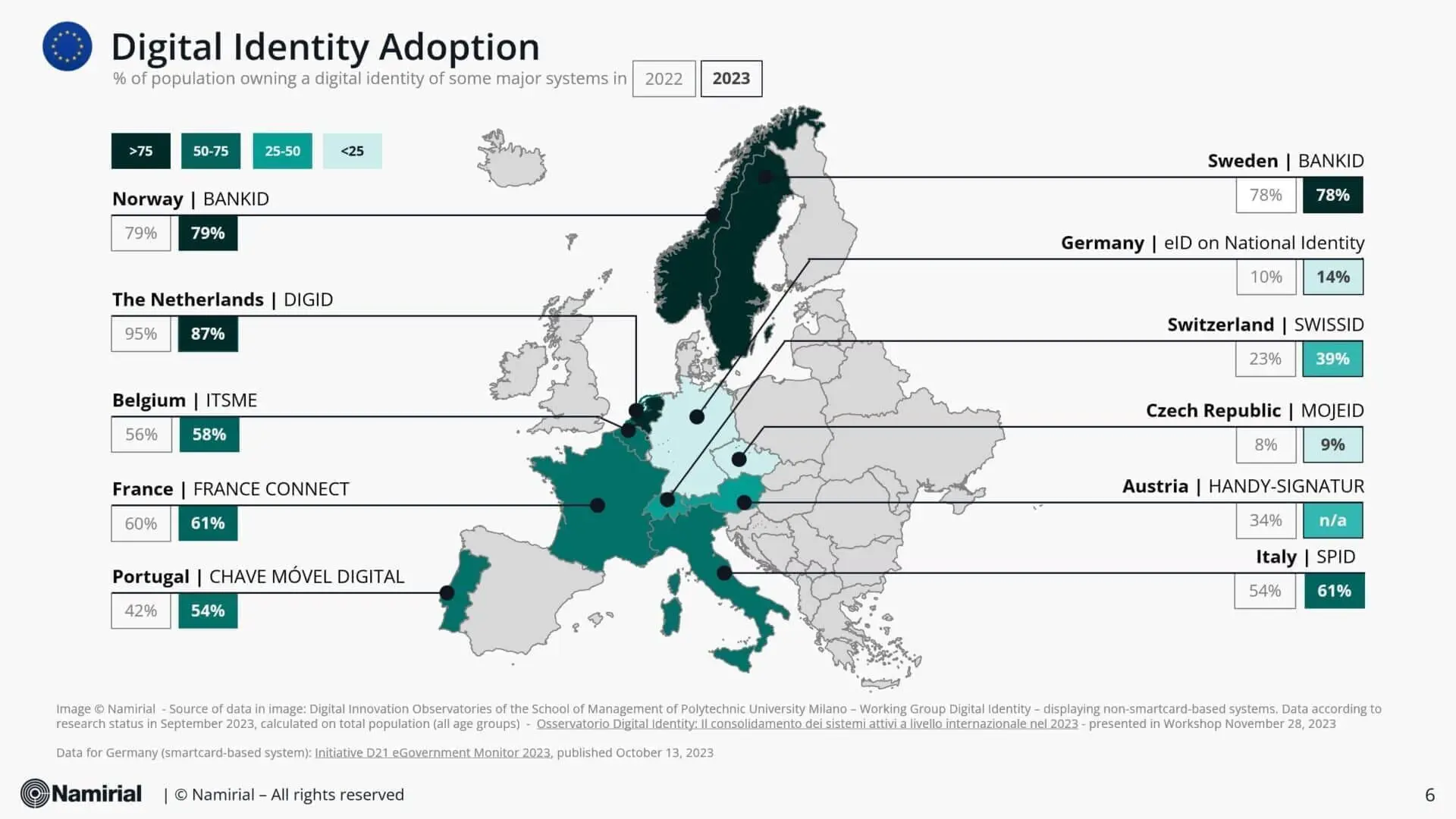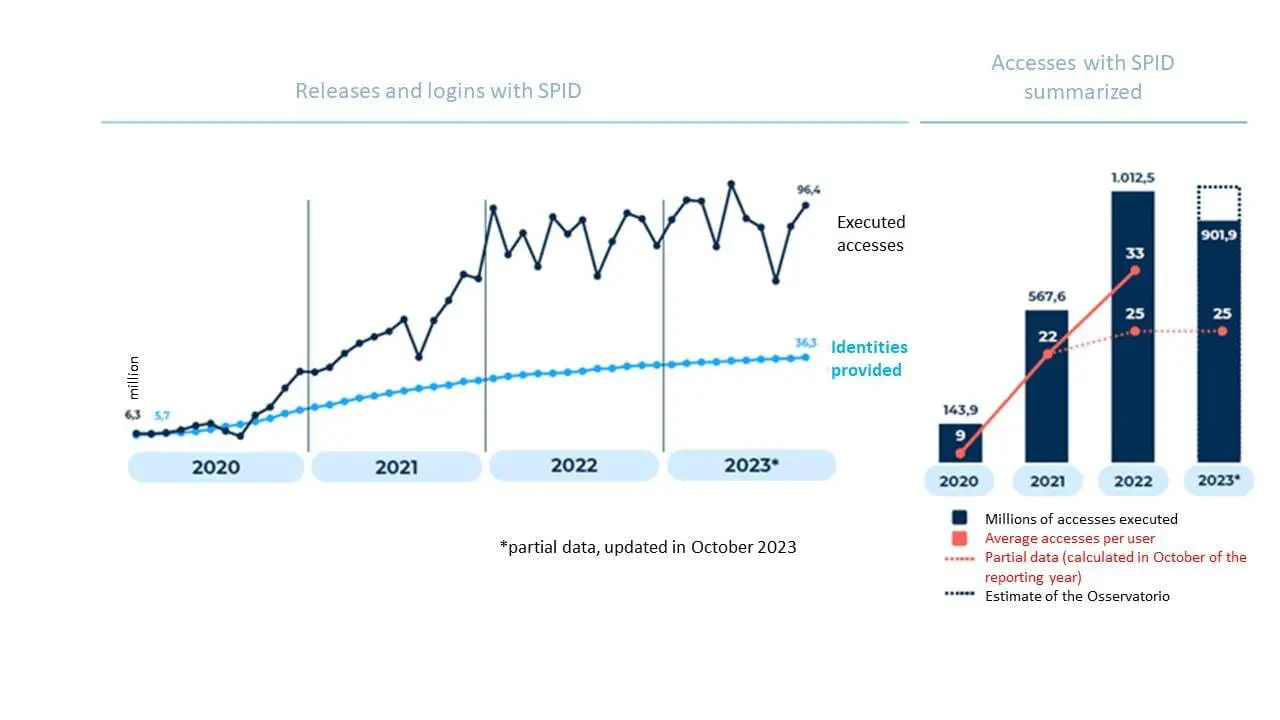(MILAN / SENIGALLIA) – December 15, 2023 – In 2022, Italy has made great strides in the use of digital identities, according to recently published data from the Digital Identity Observatory at the School of Management at the Politecnico di Milano. The detailed research findings, based on in-depth empirical research and analysis, were presented at the final conference of the Digital Identity Observatory on November 28, 2023.
Namirial supports the work of the interdisciplinary think tank of professors, researchers and analysts, which addresses key issues of digital innovation. The independent research project on digital identities was initiated to expand the understanding of the potential of digital systems for identification and authentication. Experts from Namirial have been contributing their expertise to this research project since its launch in early 2020.
At the European level, the trend that was already evident last year is confirmed, with the penetration rates of non-smart card-based digital identity systems remaining essentially stable in those countries that had already reached significant percentages and increasing more markedly in those countries that assumed lower penetration rates.
Among the countries in the first group, Norway confirms a rate of 79% for the third year in a row, Sweden rises to 81% (+3% compared to 2022), while the Netherlands decreases to 87% (its DigId digital identity system records a decrease of -8% compared to the record rate of 95% in 2022).
Italy has a user rate of 61% (+7% compared to 2022), catching up with France (where the France Connect system is only growing by 1% compared to 60% in 2022) and overtaking Belgium, whose itsme system is growing by 2% compared to 2022, stopping at 58%. Interesting growth rates can be seen in Portugal (54% penetration rate, +12% compared to 2022), Switzerland (39%, +16%) and Austria (34%, +12%). However, the data for Austria in 2023 is missing – this is presumably due to the transition from the HandySignatur to ID Austria, which has been official since December 5. According to research by Namirial, 1.6 million users have currently registered for ID Austria. This makes identification very easy via smartphone. Austrians also no longer have to physically carry their driving license with them, but can simply store it in the ID Austria. In addition to these functions, administrative procedures can also be carried out completely online.
The electronic identity on the German ID card is still struggling with acceptance problems. Compared to 2022, the eGovernment Monitor of the D 21 initiative only shows an increase of 4 percentage points from 10% to 14% in the use of electronic identity on the ID card. Even in the digitally very affine population groups, users are in the minority: in Generation Z the proportion is 28%, in Generation Y 16%.
The two oldest generations in Germany hardly use the online ID function at all (post-war generation: 8%, generation up to 1945: 1%)
The majority of German citizens (62%) are familiar with the online ID card: one in four people are confident enough to explain what the online ID card is.
A further 37% in Germany state that they know at least roughly what it is all about. This means that an important basic requirement for use, namely awareness, has been met. However, the first hurdle on the way to using the online ID card is that the online function must be ready for use: Today, every ID card is delivered with the online ID function activated, but it only becomes operational when a PIN is entered. This has been done by 30% of the German population and they therefore have a ready-to-use online ID card. However, one in two people have not taken this step, and a further 21% state that they do not know the status of their ID card.
Italy’s success in digital identity adoption is primarily based on its Public Digital Identity System (Sistema Pubblico di Identità Digitale, SPID). This national system is enabling Italian citizens, persons with permanent residence permit and Italian businesses to access public administration services online.
- Italian citizens 18 years and older as well as foreigners holding a permanent residence permit and residing in Italy can apply for a digital identity in this scheme.
- Since September 2018 SPID is a system for electronic identities notified to the European Commision under EU Regulation 910/2014 on electronic identification and trust services (eIDAS).
- Namirial is one out of ten digital identity providers within this system, audited according to ETSI Technical Standard EN 391 401 by Bureau Veritas.
The following statistics have been presented by Digital Identity Observatory at a conference in Milan Polytechnic University November 28, 2023 plus we were adding some more data more recently published.
Use of the Public System for Digital Identities in Italy: SPID and CIE
The public digital identity system SPID is by far the fastest growing system for digital identities in Italy, with more users than the system for electronic identification based on the national identity card (Carta d’Identità elettronica, CIE).
In 2023, Italy had to make important decisions when it came to allowing SPID and CIE to coexist. Despite the renewal of the SPID identity provider agreements in May 2023, which are valid for the next two years, it is now clear that the current administration’s strategy is to converge these two systems.
- To date, around 36.4 million adult citizens in Italy have used SPID – equivalent to 73% of the Italian population. Among those under 18 years of age, the figure is 0.18%, i.e. about 13,000.
- As with other systems at an international level, SPID seems to have reached something of a plateau in the number of applications, with a lower growth rate than in recent years: the number of identities increased by 9% from January to November 2023, while it had increased by 23% in 2022.
- The total number of logins with this digital identity system seems to remain stable and will exceed 1 billion in 2022. So far, the average annual number of accesses by a single user in the current year is 25 in 2022.
- SPID has now established itself as the key to access to public services, while adoption in the private sector still does not fully exploit its potential.
- The development of the CIE also continues, which is in the hands of 39.3 million citizens (+23% compared to November 2022). Despite the widespread use of physical documents, the digital version of the CIE, made possible by the CieID app, is still far too underused: around 4 million users have so far chosen this tool to access online services.

Digital identity in public administrations and companies
The Public Digital Identity System is not only used by citizens, but also by public or private service providers.
- Over 12,000 public administrations are offering at least one service online through SPID by November 2022.
- 141 private companies had joined SPID by October 2022 (19 joined CIE). Potentially, almost 175,000 companies are interested in joining SPID, which shows the excellent growth opportunities that could arise in the near future.
The pandemic has prompted large companies to offer onboarding methods (i.e. remote recognition) to ensure business continuity, but we are still a long way from a mature and strategic vision of digital identity. 80% of large companies in the finance, telco and utility sectors allow you to start and finish the recognition procedure remotely and, in 80% of cases where it is necessary to verify the data entered by the user, carry it out without having to go to the counter.
Companies are starting to integrate recognition methods without passwords or pins, replacing them with ownership factors, such as sending via SMS or email with OTP code (42% of cases) or apps to generate OTPs or push notifications (18%). but also biometric factors (only 8% of cases). Even in more mature areas, however, there is a lack of an adequate internal structure that oversees the management of digital identity. And 63% of companies in these sectors have never evaluated the integration of nationally certified systems, such as SPID and CIE.
National Regulation in good Progress
Italy made some substantial progress in regulation use of digital identity in 2022:
- The role of private service aggregators has been defined, simplifying the membership process for companies from an administrative and technological point of view.
- Guidelines have been issued for managers of qualified attributes (such as professional registers and universities), who will be able to certify qualifications to be integrated into the dataset presented in the Public Digital Identity System.
Namirial best practices in driving adoption of digital identity
Namirial is accredited by Agency for Digital Italy (AgID) as one of ten identity providers for this electronic identity system, issuing and managing “Namirial IDs” – digital identities of natural and legal persons. Digital identities are being issued and corresponding credentials provided after successful verification of personal data.
Identification for electronic identity provisioning may be executed remote or in physical contact
- Based on electronic certificate for electronic signature – download and sign an application and upload it
- Based on electronic identity on Italian National Identity Card (Carta d’Identità Elettronica, CIE) — by using an NFC enabled smartphone and the CIEiD App
- Based on electronic certificate on Italian Health Card (Tessera Sanitaria, TS) or National Service Card (Carta Nazionale dei Servizi, CNS) – by inserting card into the reader and typing in the PIN
- Based on a video identification process in real time with a Namirial identification specialist
- Face to face by specially trained identification staff in Coop shops, and by appointment at Namirial’s offices in Italy and at Namirial’s headquarters in Senigallia.
Namirial is also supporting Professional SPID, a particular type of Italy’s Public Digital Identity System enabling legal professionals and companies to access the services of the public administration and private entities.
🔗 Detailed information on Namirial SPID offerings (in Italian language)
A European Goal: Digital Identity Wallet(s)
In the digital identity market, the European Commission’s concept for a European Digital Identity (EUid) framework, presented in June 2021, is widely welcomed. With the help of digital wallets (“ID wallets”), it is intended to enable users to store their digital identity in an app on their smartphone in order to:
- identify themselves online and offline,
- store and present official information such as first name, last name, date of birth and nationality,
- store and share information from reliable private sources;
- use the information to demonstrate a right, such as the right to reside, work or study in a particular Member State.
From 2026, EU member states will be required to provide a wallet for digital identities, in which they can link their national digital identity with proof of other personal attributes (e.g. driver’s license, diplomas, bank account, etc.). This could simplify numerous processes. Work is currently underway to update EU Regulation 910/2014 on electronic identity and trust services (eIDAS). On November 8, 2023, the European Parliament and the European Council reached a provisional agreement on the revision. Further information can be found here:
Provisional Agreement – Official Document:
European Parliament: Download of Provisional Agreement (PDF)
Press releases regarding the Provisional agreement by
European Commission: Commission welcomes final agreement on EU Digital Identity Wallet
Council of the European Union : European digital identity: Council and Parliament reach a provisional agreement on eID
European Parliament: EU-wide digital wallet: MEPs reach deal with Council
However, the approval from the population is still somewhat restrained. On average, less than one Italian user in three said they used a wallet app in the study. In this case, typically one of the apps that are already offered by your own smartphone (i.e. Google Wallet or Apple Wallet). And although the potential of these apps makes digital identity increasingly extensive, the available wallets do not yet seem to be fully integrated into users’ daily habits. In comparison: in Germany, significantly more people use such wallet apps E (28%) than the online ID card (14%). This means that more than one in four people are prepared to store sensitive documents on their smartphone – mostly out of convenience, because they always have their smartphone with them anyway (64%). However, 2 out of 3 citizens also state that they do not yet use a wallet on their smartphone. Similar to the online ID card, the most common reason for this is a lack of reasons to use it (38%). The data is taken from the current eGovernment Monitor 2023 study by Initiative D21 and the Technical University of Munich.
“Digital wallets in Europe are an expression of sovereignty,” explains Giorgia Dragoni, Director of the Digital Identity Observatory, in her presentation. “A digital European identity means that citizens can identify with Europe. So the wallets also have an identification value. People should feel part of the European Union beyond their sense of nationalism.” All roads lead to the wallet, but not all paths are the same, just as little as straight or self-evident. The most important thing is to carry out a proper migration that includes and respects what already exists. It is also essential to act in the interests of users and to make new services possible for them.
What is challenging is the path ahead for private players in this market, who, in order to survive, will have to rethink their position towards the users and, above all, their role in a changing ecosystem whose boundaries are not yet well defined.
The path that international consortia must take is also clearly outlined: not only do they have to find mechanisms for cooperation in the different areas of work, but they also have to develop the prototype of the new wallets in a legal framework that has yet to be defined in detail.
However, some questions remain unanswered, such as the distribution of costs. There is also the question of whether there will be a single state wallet or many different ones that can be launched on the market by different private providers.

